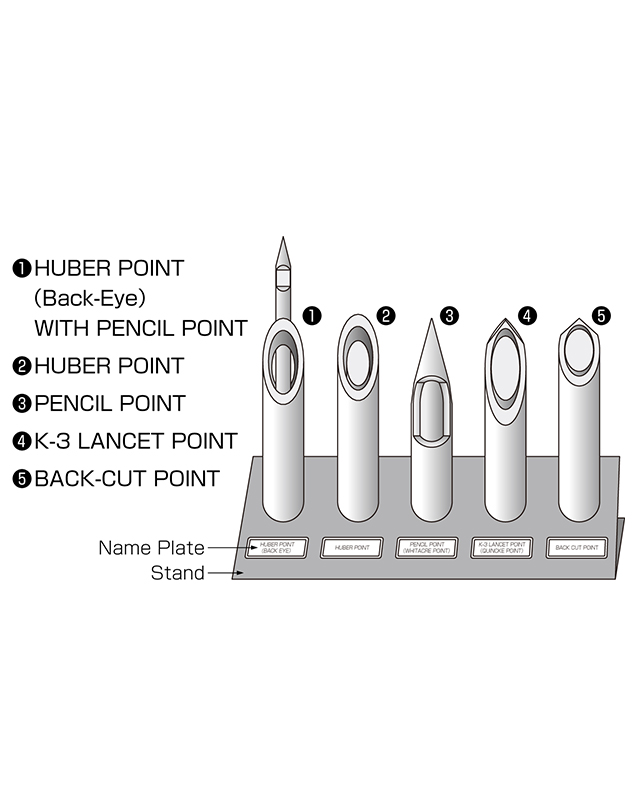EDUCATIONAL NEEDLE POINT MODELS (FOR ANESTHESIA)
For providing reliable informed consent to patients or promoting visual understanding at clinical trainings.
This educational set provides visual and effective understanding of 5 types of needles most commonly used for anesthesia.The magnified needle-tip models demonstrate characteristics and differences of actual needles.This is ideal tool for providing better informed consent and puncture training.
| Component | Q’ty | |
|---|---|---|
| Needle Point Models | HUBER POINT (Back-Eye) WITH PENCIL POINT | 1 |
| HUBER POINT | 1 | |
| PENCIL POINT | 1 | |
| K-3 LANCET POINT | 1 | |
| BACK-CUT POINT | 1 | |
| Stand | 1 | |
| Booklet : The History of Needles(for Anesthesia) | 1 | |
| Instruction For Use | 1 | |
| Certificate of Warranty | 1 | |
| Storage box | 1 | |
特徴

PENCIL POINT
The needle tip is shaped into circular cone or bullet with side-hole for injection of solution. This shape is used for Spinal Anesthesia and is characterized by low CSF outflow due to early occlusion of puncture hole originating in non-cutting tip. Its original model was designed by Dr. Whitacre in USA, so is called as WHITACRE POINT as well.

K-3 LANCET POINT
K-3 LANCET POINT can be described as modification of LANCET POINT, and is mainly used for Spinal Anesthesia. The original model was designed by Dr. H. Quincke in Germany, so is called as QUINCKE POINT as well. It is characterized by appropriate penetration resistance and ease of handling in puncture.

BACK-CUT POINT
This needle tip is widely used for biopsy needle, nerve blockade needle, central venous puncture needle, etc. This type of point, generally, has higher resistance in vertical puncture, while it is characterized by inducibility to the target site, moderate puncture resistance and straight-advancing property.
HUBER POINT
This needle tip is curved toward bevel face, and mainly used for Epidural Anesthesia Needle. Originating in the hypodermic needle designed by Dr. Huber, a dentist in Seattle, this model was applied to Epidural Anesthesia by Dr. Tuohy and thus called as TUOHY NEEDLE as well. The most recent design is known to be modified by Dr. Hustead.


HUBER POINT (BACK-EYE)
HUBER POINT (Back-Eye) was developed by Dr. Hanaoka in Japan. A kind of Huber point with a hole (Back-Eye), from which a spinal needle is advanced through Tuohy needle for CSEA. Almost all Unisis spinal needles pass through Tuohy needle smoothly with excellent puncture performance.
* Please inquire at us for the product.
Back to products lineup page





